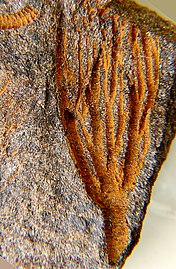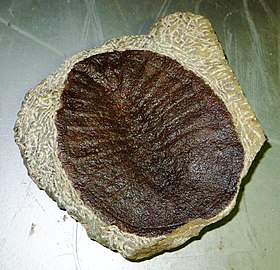Letná Formation
| Letná Formation Stratigraphic range: Sandbian () ~460–450 Ma | |
|---|---|
| Type | Geological formation |
| Underlies | |
| Overlies | |
| Thickness | >600 m (2,000 ft) |
| Lithology | |
| Primary | Sandstone, shale, siltstone |
| Other | Limestone, quartzite |
| Location | |
| Coordinates | 50°00′N 14°00′E / 50.0°N 14.0°ECoordinates: 50°00′N 14°00′E / 50.0°N 14.0°E |
| Approximate paleocoordinates | 58°24′S 81°42′E / 58.4°S 81.7°E |
| Region | Prague |
| Country | |
| Extent | |
| Type section | |
| Named for | Letná Hill |
| Named by | Havlíček & Vaněk |
| Location | Malá Strana, Holešovice, Prague |
| Year defined | 1966 |
| Coordinates | 50°05′40.5″N 014°25′03.0″E / 50.094583°N 14.417500°E |
 Letná Formation (Czech Republic) | |
The Letná Formation is a Late Ordovician (Sandbian, or in the regional stratigraphy ) geologic formation of the , Bohemian Massif in the Czech Republic. The formation crops out in the Czech capital, more specifically at Letná Hill, after which the formation is named. The type locality is located at Malá Strana, Holešovice district.[1]
The more than 600 metres (2,000 ft) thick formation comprises a rhythmic alternation of sandstones (greywackes and ), quartzites, intercalated with siltstones and shales deposited in marine flysch-like environments.
Because of the excellent preservation, including gut remains, of a wide assemblage of early Paleozoic taxa in which trilobites dominate, the formation, which is lean in fossils in many areas but exceptionally rich in what has been interpreted as storm beds, has been designated a Konservat-Lagerstätte.
Description[]
The Letná Formation was first formally defined in 1966 by Havlíček and Vaněk and crops out in the , a northeast–southwest trending minibasin stretching over 100 kilometres (62 mi) between Rokycany in the southwest and Úvaly in the northeast. The Prague Basin contains an Ordovician to Devonian succession in the larger Bohemian Massif.[2] The formation conformably overlies the and is overlain by the .[3] The Letná Formation is the thickest unit in the sedimentary sequence with a thickness of more than 600 metres (2,000 ft) between Beroun and Prague.[4][5]
The formation consists of a rhythmic alternation of sandstones (greywackes and ),[1] quartzites, intercalated with siltstones and shales with limestone lenses in the upper part of the succession, deposited in a shallow marine environment, representing a flysch deposition in the early Paleozoic. While in most of the layers fossils are absent, certain levels contain a rich assemblage of shallow marine fauna interpreted as storm-induced beds.[4] The concentration of a wide variety of excellently conserved fossils of the Letná Formation has granted it the name of a Konservat-Lagerstätte, giving insight into the diversification of marine ecosystems.[6]
A rather diverse fauna composed of brachiopods, trilobites, echinoderms, conularids, and non-trilobite arthropods has been found in outcrops located between Zdice and Chrustenice. This area probably represented a rather shallow environment in the northwestern part of the basin. The fossils are usually fragmentary and preserved as internal or external moulds associated with angular claystone fragments within quartzose sandstones to siltstones. Accumulations of these fossil remains are commonly found in thick-bedded quartzose sandstones of light-grey and yellow or grey-brown color, which might have been deposited in areas sheltered from wave activity by sand bars.[5]
Five communities of marine fauna were identified in the formation. The rich brachiopod dominated Community is associated with shallow water, well-sorted quartzose sandstones. The Community, which probably represents a slightly deeper environment, is typically found in the poorly sorted greywackes of the higher horizons of the Letná Formation. These two communities constitute the - Fauna. In more proximal environments, this fauna is replaced by the trilobite-dominated Dalmanitina- Association, which contains Birmanites ingens and . The more distal, probably deeper parts of the basin are characterized by a poorly diversified assemblage of trilobites associated with rare graptolites. Lastly, trilobites of the so-called Cyclopygid Biofacies and brachiopods of the Association are typical for the deepest portions of the Prague Basin. Intertidal (Skolithos ichnofacies) and near-shore (Cruziana ichnofacies) environments are also evidenced by ichnofossils.[7]
Fossilized gut remains have been observed in four of the about twenty trilobite species present in the Letná Formation: Birmanites ingens, Dalmanitina socialis, and . These four trilobites belong to the Dalmanitina-Deanaspis Association, characterizing rather proximal and shallow environments of the Letná Formation. Most of the non-trilobite arthropods discovered in this formation, including forms with non-mineralized exoskeletons, are also found associated with D. goldfussi and/or D. socialis. This suggests that the development of conditions conducive to soft-tissue fossilization was not uncommon in the environment represented by the Dalmanitina-Deanaspis Association.[7]
Fossil content[]
The following fossils were reported from the formation:[8]
- Trilobites
- Non-trilobite arthropods
- Crinoids
- Lingulata
- Gastropods
-
- Bivalves
- Crustaceans
- Ostracods
- Rostroconchia
- Blastoidea
- Rhynchonellata
- Craniata
- Strophomenata
- Tergomya
- Tentaculita
- Edrioasteroidea
- Eocrinoidea
- Echinosphaerites infaustus
- Cystidea obscondita
- Rhombifera bohemica
- Stylophora
- Soluta
- Scyphozoa
- Merostomata
- Polychaeta
- Machaeridia
- Algae
- Other
Gallery[]

Bicuspina multicostellata

Caleidocrinus multiramus
Duslia insignis
Holopea praestans
See also[]
| Wikimedia Commons has media related to Letna Formation. |
| Wikimedia Commons has media related to Fossils of the Letna Formation. |
References[]
- ^ Jump up to: a b Kříž & Steinová, 2009
- ^ Mikuláš, 1998b, p.143
- ^ Fatka et al., 2013, p.96
- ^ Jump up to: a b Mikuláš, 1998a, p.5
- ^ Jump up to: a b Fatka et al., 2013, p.97
- ^ Jump up to: a b c d Noheljová et al., 2019, p.69
- ^ Jump up to: a b c d e Fatka et al., 2013, p.98
- ^ Letná Formation at Fossilworks.org
- ^ Fatka et al., 2013, p.99
- ^ Pereira et al., 2017, p.466
Bibliography[]
- ; ; ; , and . 2019. New echinoderm Lagerstätte from the Letná Formation (Sandbian, Upper Ordovician) of Bohemia, 69. 10th European Conference on Echinoderms. Accessed 2020-05-29.
- ; ; ; ; ; ; , and . 2017. The illaenid trilobites Vysocania (Vaněk & Vokáč, 1997) and Octillaenus (Barrande, 1846) from the Upper Ordovician of the Czech Republic, Portugal, Spain and Morocco. Bulletin of Geosciences 92. 465–490. doi:10.3140/bull.geosci.1642
- ; ; , and . 2013. Fossilised guts in trilobites from the Upper Ordovician Letná Formation (Prague Basin, Czech Republic). Bulletin of Geosciences 88. 95–104. Accessed 2020-05-29. ISSN 1214-1119
- , and . 2009. Letenský profil, 1. . Accessed 2020-05-29.
- . 1998a. Trace fossils from the Letná Formation (Ordovician, Czech Republic). 34. 5–25. Accessed 2020-05-29.
- . 1998b. Ordovician of the Barrandian area: Reconstruction of the sedimentary basin, its benthic communities and ichnoassemblages. Journal of the Czech Geological Society 43. 143–159. Accessed 2020-05-29.
Further reading[]
- R. J. Horný. 1997. Circumbilical retractor muscle attachment area in the Ordovician trilobed bellerophontoidean gastropod Tritonophon peeli sp. n. (Mollusca). Bulletin of the Czech Geological Survey 72(4):333-338
- F. C. Shaw. 1995. Ordovician trinucleid trilobites of the Prague Basin, Czech Republic. Paleontological Society Memoir 40:1-23
- V. Havlíček and J. Vaněk. 1966. The biostratigraphy of the Ordovician of Bohemia. Sborník Geologických Věd, Paleontologie 8:7-69
- Šnajdr, M., 1956. Trilobiti drabovských a letenských vrstev českého ordoviku. [The trilobites from the Drabov and Letná Beds of the Ordovician of Bohemia]. Sborník Ústředního ústavu geologického, 22, 477-533 [in Czech, with English abstract]
- J. Perner. 1903. Gastropodes, Tome 1: Patellidae et Bellerophontidae 1-164
- Letná Formation
- Geologic formations of the Czech Republic
- Ordovician System of Europe
- Sandstone formations
- Shale formations
- Siltstone formations
- Limestone formations
- Quartzite formations
- Open marine deposits
- Shallow marine deposits
- Tidal deposits
- Fossiliferous stratigraphic units of Europe
- Paleontology in the Czech Republic
- Geography of Prague




